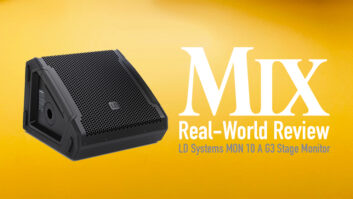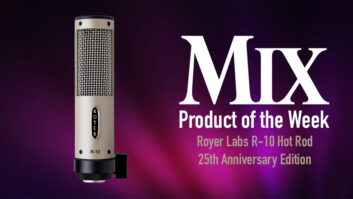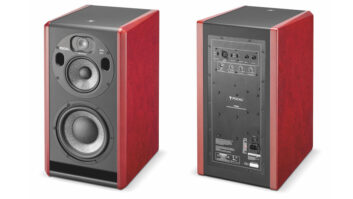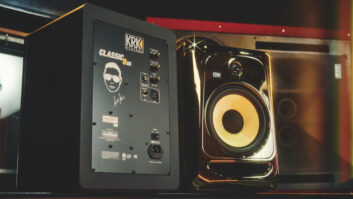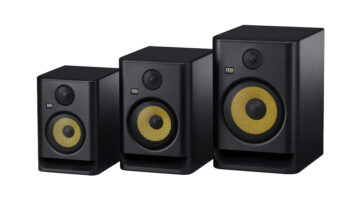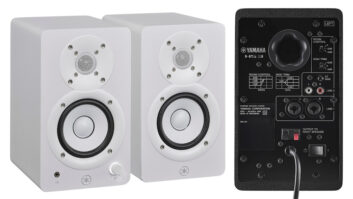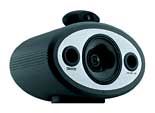

Tannoy’s Ellipse 10 monitors make bold statements on many levels beyond their futuristic-looking yet functional cabinet styling. The three-way powered monitors feature Tannoy’s Dual Concentric driver, a company mainstay since 1947, and the time-aligned Wideband SuperTweeter that extends the high-frequency response beyond 50 kHz. The monitors’ elliptical shape is said to diffuse diffraction and reflections common in rectangular cabinets.
The Ellipse Series comes in both 8-inch and 10-inch versions, with or without DSP. (Price with DSP is $5,500 a pair; without is $3,550.) Tannoy’s DSP, titled IDP for Interactive Digital Programming, uses TC Electronic’s speaker DSP and IDP software to control the crossover’s operation, add equalization for room correction and apply bass management for surround sound installations. My evaluation speakers were Ellipse 10s without DSP.
INSIDE THE ELLIPSE
The Ellipse 10’s primary driver uses a dual-magnet assembly for the center-mounted tweeter and concentric low/midrange unit. The aluminum-alloy dome tweeter has a Tulip WaveGuide horn that is appended by a molded polypropylene cone, which simultaneously reproduces the lower frequencies from the long-throw low/mid driver. Time alignment between tweeter and the low/mid driver is physically locked in all three axes with little need for electronic manipulation. Frequency response for this pair is 30 to 14k Hz with crossover at 1.7 kHz. Both the LF driver and HF tweeter use identical 200-watt discrete MOSFET amplifiers.
The SuperTweeter is mounted atop the cabinet and time-aligned to the primary driver by its physical positioning and through the 14kHz highpass crossover filter’s design. This driver has a bandwidth of 50 kHz, uses an aluminum-alloy and carbon-fiber dome, and is driven by a 30W IC amplifier. Why 50 kHz? Spectral measurements show that musical sources and speech sibilance contain considerable sonic energy above 20 kHz. Studies show that humans can detect upper harmonics, even when they are not perceived as sound.
The SuperTweeter works like the addition of a subwoofer. Subwoofers lower the system’s low-frequency roll-off and reduce phase error in low-frequency reproduction. Likewise, the SuperTweeter reduces the amount of the loudspeaker’s high-frequency phase error by shifting the tweeter’s roll-off beyond 20 kHz. The fact that the speaker system’s high-frequency phase error is reduced and all of the upper harmonics are reproduced makes for a superior listening experience.
The dual-ported Ellipse enclosures weigh more than 46 pounds each and measure 21¼ inches wide by 16⅝ inches high, including the SuperTweeter. They are made from laminated birch with MDF front and rear panels, and rest on rubber pedestals.
The rear panel’s aluminum back plate integrates the amplifier/power supply heat sink, XLR input connector (no ¼-inch or RCA jacks), +4dB/-10dBV sensitivity control and controls for a 3-band equalizer before the crossover. The LF control goes ±3 dB at 45 Hz, and the speakers come with a set of foam plugs to reduce bass below 80 Hz by closing up either or both of the two bass reflex ports. The Mid control is a broad peak of ±2 dB at 1.4 kHz, while the HF shelving control provides ±3 dB at 25 kHz — so broad that it ends up being up to ±1 dB at 4.5 kHz. I did not use the plugs or change any of the controls as I had the speakers in an open space, away from corners, above the console and in a fairly dead room with minimum acoustic treatment. It sounds wonderful to fully crank up the HF, lending an openness and “air” to the overall sound.
ACCURATE FROM TOP TO BOTTOM
The Ellipses reminded me a lot of the Tannoy 800As I use to mix on, but much better. I first listened to finished CDs and “mixes in progress” at home and then down at the studio, where I put them to work mixing multitrack sessions. My test with any new near-fields starts with establishing track size and gauging overall top and bottom qualities at loud levels on the studio’s main monitors. After I had a rough track mix going, I switched down to the Tannoys to hear what would happen. The Ellipse 10s passed my test: All tonal perspectives stayed the same. There was no increased midrange, no part of the mix disappeared and the bottom end had scaled down appropriately.
After a few sessions, the Ellipses were detailed-sounding and minimally fatiguing, even while monitoring overly compressed source material. With their extra resolution, I could hear sound differences much easier between two identical microphones or the fidelity change from one compressor to another. What was barely perceptible before is now fully perceptible, which I attribute to the on-axis concentric design and better high-frequency phase coherency helped by the SuperTweeter. However, not being able to disconnect the SuperTweeter prevented me from fully confirming this.
There’s a big difference in high-frequency dispersion between sitting directly in the equilateral sweet spot and when standing up. Vertical dispersion seems a little beam-like, so I recommend placing the speakers higher than your console’s meter bridge and tilting them down slightly at the sitting position. Lateral dispersion is very good: You can still hear both speakers well, even though you are much closer to one or the other.
The Ellipses became most valuable for cross-checking my work compared to the multidriver speakers found in most studios. The concentric design is a wholly unique analytical tool for critical listening and evaluation of any audio source. I love them!
Tannoy, 519/745-1158, www.tannoy.com.
Barry Rudolph is an L.A.-based recording engineer. Visit his Website at
www.barryrudolph.com.

• For technical specs on the Ellipse iDP Series, click
here.
• To download a PDF on Tannoy’s Dual Concentric point source, click
here.
• To view Tannoy’s white paper on Wideband, “Why You Need
a SuperTweeter,” click
here.
• To view Tannoy’s white paper on “Creating the Sweet Spot,”
click
here.
